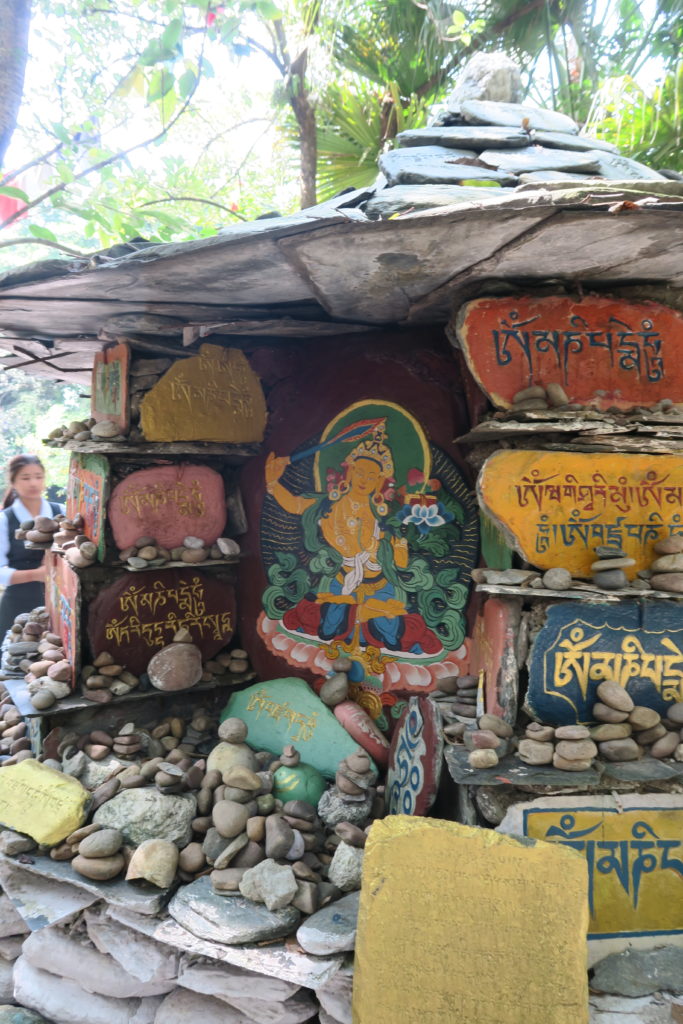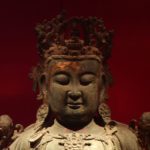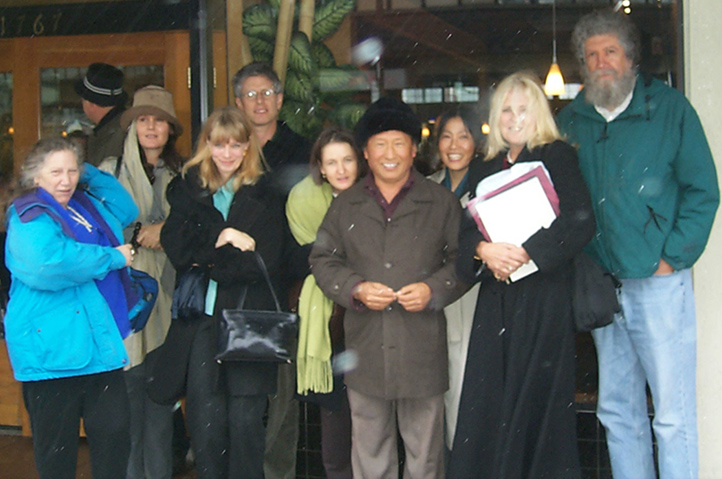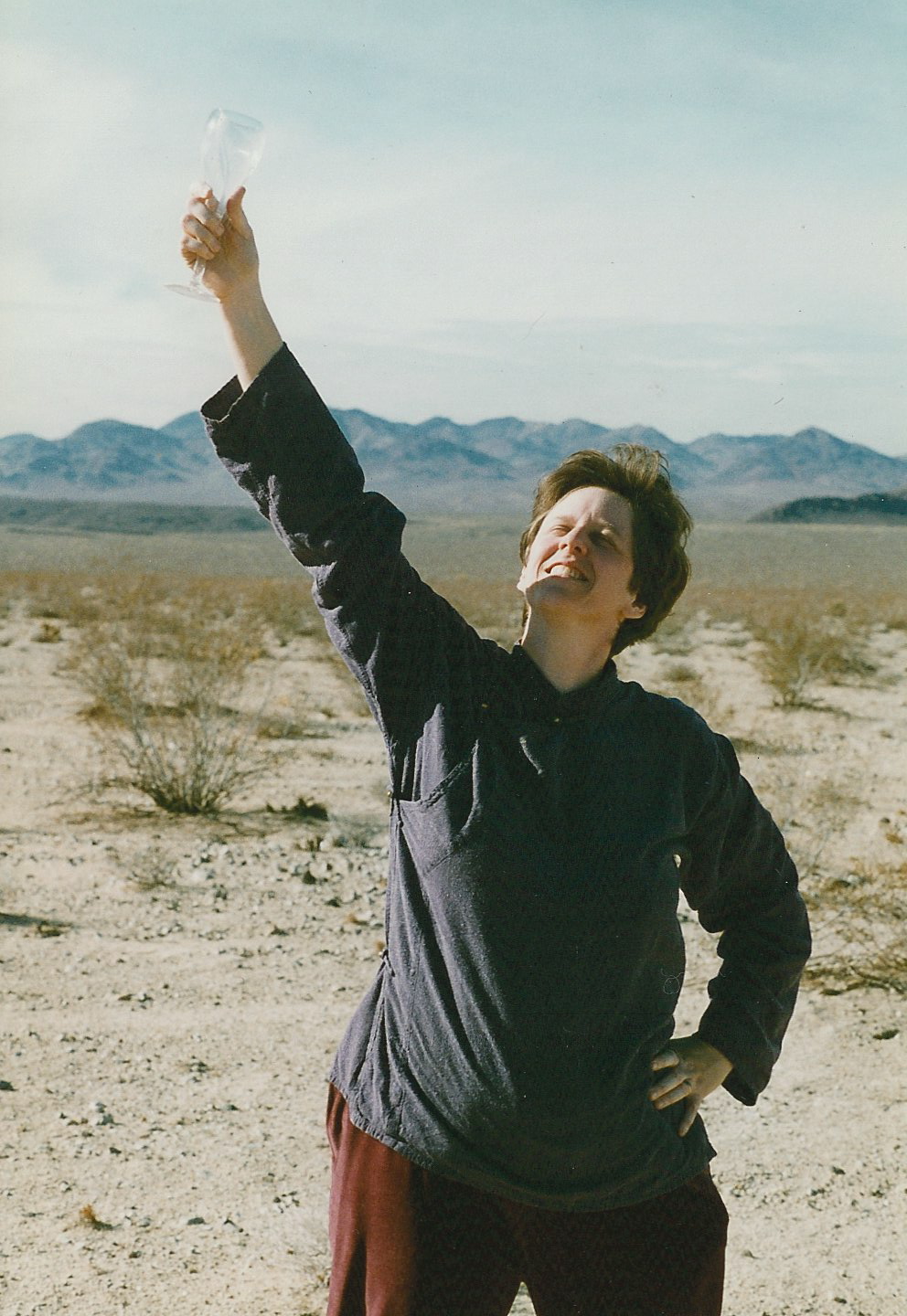April 13th, 2017
It rolls in like the fog creeping under the Golden Gate. It is the leaden, motherless, mantle of sorrow. The fundamental discernment of how short of expectations this life will fall.

My life hip joint pains me when I flex it outward. All the yoga and bodywork in the world may not make it be otherwise. For, part-by-part, my human body will fail.
I miss the optimistic glistening of a woman’s skin held close in the sunlight of some heroic locale; the tippy-top of a boulder or the City Hall steps of some Republican stronghold. Now: there are only my own soft folds of fat. My facial skin no longer snaps back flat, but falls naturally into pouty, sour, shape. Women reject me. I reject them.
The fog grabs me by the chicken neck. Cold and damp.At these times there is only one way forward: to take the hand of the loving mother as big as the world.
She balances me on her knee and brushes my hair. She stands me up and straightens my clothes. I must merely set down my many platters of good works and let her. The task of the grieving is to let her love
April 12th, 2017
If you feel stuck in your practice, as though your meditation is not creating a permanent shift away from your tired old patterns, consider introducing some deity practice from the Tibetan tradition.
In the last couple of weeks, I’ve heard from a couple of folks in Buddhist traditions famous for plain sitting practice that they’ve found some deity practice to their routine after many years in quietude. One man mentioned that he’d adopted a rarely done Korean Zen practice of self-visualization as Buddha with all symbolic the marks and signs of Buddhahood. Isn’t that interesting?

In deity practice (called by various names in the different schools of Tibetan Buddhism) you move away from viewing yourself as an ordinary human being and make your practice finding your natural Buddhaness. To to this, you re-envision yourself, born as fully awakened. Instead of a human mother’s womb, you can see that you are born from a perfect lotus flower that supports you. Your stainless mind does not split into two, taking a position based on conceptual judgements—that kind of wisdom—is represented as a flat sun on top of your lotus. Because of your vast realization, you’re always helping others in the most effective ways. The moon disk that you sit or stand upon represents this ability. The world around you is a perfect palace and the people you meet are Buddhas: you may look around and see them arrayed in all directions. Think like that.
Deity as Accelerant
There are many, many Buddhas in Tibetan Buddhism and all are ways of depicting the qualities of enlightenment. The teachings of the Buddha as told in the Mahayana sutras, say that gathering the necessary merit and wisdom to reach enlightenment takes aeons. Whole worlds can end and new ones form before you reach enlightenment from doing good deeds and peacefully meditating. If we believe that, then it is an understatement to say the pace of spiritual development from practicing Mahayana is glacial. Deity practices, and the practices that follow them, are for those who don’t want to wait that long.
Remembering the Deity means Forgetting Your Engrained Habits
There are many traditional deity practices in Tibetan Buddhism. What I have seen be a very powerful approach is for people to practice the deity/Buddha who represents the karmic habit that is most prominent in their mindstreams. We believe in karma, don’t we? Karma means our tendencies, disposition.—the ones that guide our trajectory in this life, propel us into the particular style of dumb-ass situations that we find ourselves in, over and over again. For example, when I was a kid, I tried unsuccessfully to fight off a certain kind of physical abuse. The feeling of being embattled comes up repeatedly for me, and can drag me down. Practicing the deity Vajrakilaya, a great big blue Buddha who radiates flames and wields a mighty dagger, leads the recurrent storyline in a new direction. As Vajrakilaya, I am leading an army—but it is a force raised against my own delusion. The mandala of the deity becomes a theater in which I can slay my own seemingly perpetual drama. I can wage a heroic struggle to wake up in this very life.
Someone who feels they must always strive for more and more knowledge might be drawn to the peaceful deity Manjushri, who uses a book and a great sword that cuts through stupidity with incisive clarity as tools. Ironically, he or she will develop a mind less cluttered by a multitude of thoughts become accustomed to resting in a state of pristine clarity beyond thought.
Someone who holds kind protective motherhood as the highest ideal might find him or herself working with Tara practice. In the process she may find she becomes a mother to herself and expands her love from being narrowly focused, caring for the people closest to her, and a state of uniform adoption. Everyone—human and non-human—are her children. Even within this motherhood paradigm, there are twenty-one different styles to suit every kind of divine mother; the activist Green Tara, the sensual Kurukulla, the immortal White Tara, the creative and musical Saraswati, and so on.
Guru Rinpoche is the embodiment of the ultimate guiding principle, the spiritual teacher. And within that archetype, Guru Rinpoche practices many professions, from wizard, to religious scholar, to peaceful monk, to a fierce and powerful Superhero subduing negative forces.
How to Enter into the Practice
You don’t enter into this practice on your own. A lama who has done the practice in-depth themselves initiates you. If you’ve ever seen an announcement for something called an “empowerment,” that’s it. It is usually a group event.
Before you decide to attend an empowerment, it’s critical that you investigate the lama. He or she must be someone you will be able to view purely for your entire lifetime. I suggest Googling them (“_lama’s name_____ controversy”, “_lama’s name_____ fake,” etc) and ask around before you go. Check to see that they are truly recognized and respected within their lineage of Tibetan Buddhism—Kagyu, Nyingma, Sakya, Gelug, Jonang, or Bon.
The order of things goes like this, ideally: 1. Empowerment/initiation ceremony 2. Reading transmission. 3. Instructions how to do the practice. 4. You ‘re given a practice text to take home with you.
Make a practice of viewing the lama, and circle of student were also present for the empowerment, in the best light. Leave with the contact info of someone, be it a senior student or the lama, to follow-up with if you have questions.
How to Wrestle with the Practice
Until recently, these practices were initially done in a three to six-month secluded retreat. Afterwards, you would practice it in daily life, often with a quite abbreviated text. Nowadays, most of the lamas have developed guidelines for doing these practices in working life. They are delighted when folks show up saying they want to seriously wrestle with the practice they have been given, on a daily basis. If you have already developed a disciplined daily practice routine, such as mindfulness, zen, shambhala, or vipassana, it’s appropriate to tell the lama that. You can say “I already do x minutes of silent sitting practice a day.” You can ask “How can I work this into my routine?” How you integrate the practice with your life should be in harmony with the lama’s instructions. Because the great lamas of today often travel the world and have many students, you may or may not see them again in the near term. But, still, you should think that tyou are practicing in concert with the lama and the specific lineage of enlightened masters that preceded him or her.
You will recite mantras and count them with a mala or counter, apply yourself to visualizations, cultivate an enlightened perspective. At its most basic level, the practice is like any mindfulness meditation of the various Buddhist traditions. You bring your attention the object of focus. Your attention wonders. You gently bring it back. Sound familiar?
This is one way you can take the fruit as the path. By that I mean you can focus on deities, representations of enlightenment itself, as a practice. Your need to chatter is given something to do; recite mantra. Your busy thinking mind is given something to do; visualize. Your restless body is given something to do; count mantra.
While maintaining a trusting and respectful attitude toward the lama, you can have some curiosity and an open mind. Notice what your experience is after a day or a week of doing a deity practice daily. Has anything shifted? What? After another week or month, you can ask someone close to you how you have seemed to them lately. While it’s a long shot that you will break through to the Bodhisattva levels in that time (maybe everyone has but me, I have no way of knowing) changes are possible in a short period. These can be built upon over months or years.
March 27th, 2017
Practicing as Deity/Buddha
Practicing deity gets us out of our narrow little minds and forever changes us. Viewing ourselves as a fully enlightened being from the start of our day to the very finish helps us skip steps on the path of awakening. It’s called “taking the result as the path.” We envision ourselves, not as a flesh and blood mortal with limitations, but as a transcendent being of made of light, in a web of connection with all the Buddhas of the past present and future.
It sounds trippy, and akin to New Age talk. But really it is a very grounded way to practice. You may actually find yourself as being characterized as less “spiritual” than many people around you. You’re not dependent on fantasizing about things like aliens and “the other side.” Your path has nothing to do with reifying supernatural experiences.

As a Buddhist practitioner of deity, engaging in the recitation of the sound of deity (mantra), the self-characterization of your body as light, your mind as vast and awakened, you become a big picture person. You naturally are more patient, and your vocabulary starts to reflect that as words like “aeons,” “universe,” “expanse,” “limitless” creep in, unbidden. As Lama Tharchin Rinpoche one said, “the deity never goes to the emergency room.” Your body goes to the emergency room, but your mind regards the doctors and nurses as the retinue of your deity, and the hospital as the deity’s palace.
The Role of the Wisdom Lama
It is the wisdom lama’s job to give you the empowerment, oral transmission, and instruction on the practice… and to convince you that this deity practice is the most important and special one in the whole world. (I mean the boundless universe.)
Then, you take the sacred text you are given home and merge with it. Let it help you recognize that you were born from stainless purity, envisioned as a lotus seat after having been conceived as a non-conceptual core sound such as TAM, HRIH, or HUNG. You are powered by the turning wheel of a mantra, not material food and cellular mitochondria.
A practical, stable, way of practice that is not dependent on your material body being perfect or the circumstances of life being calm, quiet or pleasant. Perfect for these times, where external appearances are speedy, constantly changing, frightening.
Engage with the wisdom lamas, don’t be a passive lout who just goes to ceremonies for the blessings. Take up a deity practice you are given with curiosity and fortitude and the payoff will be immense.
March 3rd, 2017 Part 2: Honesty
|
Dharma Speech Part 2
Another way you can tell if others are putting the Buddha’s teachings into practice is by how honest the person is. Honesty is one of the most basic values all practicing Buddhists hold. For aspiring Bodhisattvas the emphasis is on one’s motivation, taking into account that lying may be necessary out of compassion or the wish to bring all living beings to complete awakening.

I always thought of myself as a straight shooter, but I remember when I first formally committed to the Buddhist path, twenty-three or twenty-four years ago, that there was a transitional time where I started noticing how often I told lies to protect myself.
Now, as I wrote that last sentence I noticed that I wanted to say twenty-four rather than twenty-three. Honestly, I don’t remember whether I formerly took refuge at Karma Choling center in Vermont in 1993 or 1994. Why did I want to say the higher number? I guess to increase my own status… as if anyone cares but me!
So, there you have it, pride, anger, and desire still welling up from within and infecting my speech. What good is practicing a lot for twenty-three years, (ten months, five days, forty-five minutes!) if I still have afflictive emotions present in me? Well, I think there is good. Nowadays, I have a pause button. I recognize as I am typing, and hopefully most of the time when I am speaking, what my motivations are for what I am communicating. Less blurting, more pausing.
Gradually, even the lying that is societally condoned with a nudge and a wink, such as lying on a job application or in a dating site, becomes impossible.
If you want to, you can commit formerly to not telling lies by intentionally taking a vow. All nuns and monks have taken this vow, but a non-monastic male practitioner (upāsaka in Sanskrit, Genyen in Tibetan དགེ་བསྙེན་) or female practitioner (Skt. upāsikā; Tib. genyenma དགེ་བསྙེན་མ་) may also take the vow for one day, or for a lifetime.
The classically recounted consequences of lying are that you are not believed by others. You are doubted. You experience others lying to you. All attempts to collaborate harmoniously with others fail, there is in-fighting on your team. People cheat you and you are afraid.
I have these kind of experiences in my life, and part of my practice is to not point fingers at others but recognize that I am experiencing the result of having lied in this or previous lives. There is only one way to reverse that, and it means pausing and being super-careful about about honesty. Although it’s not easy and I sometimes fail, I recommend it. Try it for a day and notice what happens.
|
|
March 2nd, 2017
Part One: Harsh Speech
How can you tell a Dharma practitioner—someone who puts the Buddha’s teachings into use—from someone who studies Buddhism intellectually?
It’s often as simple as listening to them speak.

One of the first teachings we receive as Buddhists is how to avoid non-virtue—to shun negative thoughts and actions that will come back to bite us in the ass.
So there you go, the word “ass.” To most of us in English-speaking countries these days, the word ass is as un-alarming as saying butt or behind. When I grew up in the 1960’s, ass was a profanity that could send you to the principal’s office. Yes, really. So, although I use this word, it sets off a little alarm in me that it might not set off for a younger American. I pause and consider whether or not I want to use it. In Buddhism we say that we should avoid harsh words because if we use them we will then reap the karmic fruit of hearing unpleasant words in the future and have rough, difficult life circumstances in general.
But, clearly, whether we use the word ass or not is no big deal. Here, “ass” is not the best word to use as an example. What if I call someone an asshole? Why would I do so? Is it because I am mad at them? Anger is one of the core emotions that poison our lives. If I am using harsh angry words, they can function as weapons. So, our mind can be poisoned by anger and instead of stopping and shutting up and being careful not to act on that anger, I have gone one step further and let it leak into my speech, potentially arousing painful emotions in the minds of the hearer as well. Without a doubt, anger creates a negative trajectory for one’s consciousness, and karmic repercussions are inevitable.
Maybe I called that person an asshole because I wanted to be accepted by others. An example would be calling President Trump an asshole on my Facebook page. I know about 95% my Facebook friends are liberals opposed to Trump. Am I trying to be liked by calling him names? That plays into desire, another one of the three poisonous emotions.
Or, perhaps I am not thinking about how my speech reflects my mental state or how my words impact others. Yes, that comes from a mental/emotional poison as well, the poison of ignorance/stupidity.
Are people always putting you down? Do they say harsh rough things to you that disturb your mind? According to Dharma, you can look at that present situation and see what kind of karma you have accumulated in this life and/or prior life for the roots of that experience. The Main way to actively change that patterned experience is to watch every word that comes out of your mouth and avoid slandering people, no matter how deserving they may seem to be.
When I say it is easy to tell who is a real Buddhist practitioner versus someone who keeps the teachings in the realm of intellect, I mean they are people who refrain from blurting out every thought or feeling that comes into their minds. They either pause before responding to an emotion-laden question or have so perfected the habit of virtuous speaking that they automatically default to words that are true, gentle when possible, necessary, and break down divisions between people.
It’s good to reflect on our motivation for what we are about to say, especially when there is a lot of feeling behind it. To check in on what we feel in our body when we mentally rehearse saying those words.
For example, one time I called Donald Trump “the Evil Pumpkin.” I have called Hilary Clinton a “corporate shill.” If I say “Donald Trump is an Evil Pumpkin” to myself, I feel it high in my chest. There a sense of victory in saying that, and pride that I was smart enough to make up a new insult for him. But Dharma is not about being victorious, in fact there is a famous mind training slogan that says, “Gain and victory to others, loss and defeat to oneself.”
Of course, I can make political rationales for almost any non-virtuous words I utter or write. But, another famous mind training slogan states: “When the world is filled with evil, transform all mishaps into the path of bodhi (awakening.)” We can work to protect living beings from danger without undermining our store of merit by indulging in personal expressions based on desire, anger or ignorance.
Do I lapse at times? Yes! But, I am way different than I used to be.
Slowly, slowly, we can train our minds inwardly, and outwardly we will see the words and deeds that reflect the three poisonous states of mind diminish.
February 14th, 2017 Some folks say Buddhism is a religion. And it has many of the trappings of religion: large hierarchical institutions, canonical principles, male scholars who debate how many angels who can dance on the head of a pin, beliefs in concepts that cannot be proven, and so on.
Others say it is a philosophy, a more dispassionate, and perhaps intellectual, system of inquiry. Some followers of the current secular Buddhism movement might subscribe to that view.
I’d argue that Buddhism is about you and your mind.

I know, I know. What is “you” if it is not your mind? That question leads you down a rabbit hole into the very heart of Buddhism. What is this thing I identify as my self, and what is happening when we ask the self to look at the mind? Is the mind over there and self over here? Where? The questions go on and on, not looking at those kinds of questions intellectually, but instead very intimately. More intimate than sex. Getting at the very core by looking inside again and again in a simple, humble way.hose
Am I saying that monasteries, Dharma education, beliefs, good conduct and all the other things we associate with Buddhism should be done away with? Not at all. Everybody needs guidance and inspiration. At the end of the day, though, Buddhism is found in the moments when we apply all the techniques we have learned to our own minds and the timeless time that happens when we drop the technique and rest in the space beyond questions and answers.
January 23rd, 2017
‘Gathering Circle’ —A Buddhist Practice
The most common group activity participated in by practitioners of Vajrayana Buddhism is a gathering circle. In the Tibetan language, this is called tsok (short for tsok kyi khorlo, which literally means gathering circle). Gathering circles opportunities for practitioners to assemble in the recognition of each other’s inherent divinity, and the environment as a sacred circle, and confess any deviation from that pure perspective. To accomplish that, they recite a vivid and poignant text together, related to a symbolic enlightened deity—for example the Buddha of Compassion (Chenrezig,) or the emancipator Tara—and make offerings. The special features of gathering circle practice are a collective acknowledgment of points of deviation from sacred outlook, a reaffirmation of our promises, traditional and votive offerings of food and drink.

Tibetan and American Buddhist Practitioners at a California outdoor gathering circle
The practice can be elaborate, involving an orchestra of traditional musical instruments, sculptural dough offerings known as torma, and complex mudra (symbolic gestures). Or, it can be quite simple and brief. They can take place anywhere.
An example of a commonly practiced simple tsok text is Shower of Blessings, an arrangement that centers on a famous prayer to Guru Rinpoche/Padmasambhava.
Practitioners typically participate in a gathering circle twice a month at minimum, on the tenth day of the Tibetan lunar calendar and the twenty-fifth. These days are tracked by English-speaking practitioners via Dharma centers’ online calendars or a hard copy calendar published by the Rigpa organization. Some practitioners adapt the schedule of tsoks to their western work week.
Gathering circles that take place outside of a large Dharma center requires everyone play a role and work harmoniously together. Each participant brings an offering of food or drink. Some people are involved in cleaning the room and setting up the shrine. Others prep the food offerings. and place them on the offering table. Skilled people play the main roles in the ceremony, for example, leading the chanting of the text or playing of an instrument.
At its best, tsok is a pristine, joyous, experience of mutual love and support that creates bonds between one’s close “family” of students under the same teacher (lama) or group of teachers, heals rifts, and creates a fresh start for high quality practice during the two week period that follows.
If you wish to go further and read a brief teaching on the meaning of tsok, here is a pdf from the late Lama Tharchin Rinpoche. http://www.vajrayana.org/media/files/files/7a48b5b8/Brief_Teaching_on_the_Practice_of_Tsok.pdf
January 20th, 2017
Garden Variety Depression and Anxiety can be helped by Mindfulness-Awareness Practice
The Buddha, in the second of his famous Four Noble Truths taught that suffering arises from craving and clinging to temporary things. When we don’t get what we want, we experience aversion or hatred towards what happens instead. It is out of ignorance that we get caught up in these two—desire and aversion—so ignorance can be said to be the root of all suffering as well. These three are called the “three poisons.” According to Buddhist thought, all painful emotions are the result of these. For those who believe in rebirth, as I do, the three poisons are also what lead to karma and rebirth as ordinary living beings in the wheel of suffering (samsara.)

We usually take our thoughts very seriously and are unaware of how the movement of energy in our nervous systems, coupled with inputs to our five senses, generate thought fragments based on our deeply embedded habits of reacting with desire, aversion and ignorance. Then, thoughts and concepts arise, and these concepts eventually turn into painful emotions. We blame other people or ourselves for our problems because the workings of our minds are invisible to us. We lack perspective, so we point the finger.
Basic mindfulness-awareness meditation works because it eventually allows us to see our thoughts and thought fragments bubble up again and again. Being wise to what is going on we gradually decrease our fascination with them, we bring our attention back to our outgoing breath instead. This style of meditation temporarily pacifies our endless wanting mind. Over time, painful emotions gradually weaken their grasp on us.
In my personal experience, mild to moderate depression can be reduced in frequency, severity and duration by mindfulness awareness practice and contemplative practices, and the tendency can potentially be eliminated through other practices tailored to the individual. I am inclined to believe that severe depression (Major Depressive Disorder) and manic depression (Bipolar Disorder) are physical illnesses that will not likely resolve through meditation. They will require some kind of medical approach.
As is well known in the modern field of cognitive-behavioral psychology, many people with chronic or relapsing depression and anxiety benefit from therapy that challenges a person’s entrenched beliefs about the world. For example, tackling directly concepts like, “I’m a useless bother to everyone in my life,” or “the world is a hostile place,” can reduce depression. Thoughts like “Something bad is always likely to happen.” etc, can be reduced, and anxiety can diminish. Anxiety is usually centered on thoughts about the future and depression on thoughts from the past, but this is not always the case.
Getting to the Root
If you see one drowning person after another being carried downstream in a river, you should definitely save as many as you can. But, wouldn’t it be more effective to go upstream and stop people from falling into the water in the first place? That’s what Buddha would say.
Mindfulness-Awareness practice, or meditation combined with therapy, can help one gain insight into the fundamental essencelessness of our thoughts and concepts. Gazing at the instantaneous formation of our treasured beliefs about the world without judgment reduces how seriously we take them. The gaps between thoughts lets some sunshine in.
January 13th, 2017
Could Unequal Compassion have been the Roots of my Depression and Anxiety?
For the last two blog posts I have been recounting how, in searching for enlightenment, I unexpectedly resolved chronic depression and anxiety. Blogging experts tell you never to talk about I, I, I. You want to know what can help you, right? Who cares about some stranger n the internet.
I do want to help you. But, honestly, I don’t know whether what I did will help you. I think my anxiety and depression was the kind that might have also responded to cognitive-behavioral therapy, the kind of therapy that works on changing your ways of thinking about the world. I did do regular talk therapy during the years we are talking about and it certainly helped. But I feel that, although mindfulness-awareness meditation and therapy pulled me out of my “nervous breakdown,” it was the foundational practices of another Buddhist path called Vajrayana that gradually transformed my worldview. For that, I will be eternally grateful.
 Lama Tharchin Rinpoche and some of his students, Albany, California 2001. Lama Tharchin Rinpoche and some of his students, Albany, California 2001.
Meeting my Lama
It was early in 1997. A friendly guy named Josh handed me a copy of a red booklet. Inside were washed-out photocopied pages of the preliminary practices of the Dudjom Terser tradition of Nyingma Buddhism, called the ngondro in Tibetan. Inside were many practices joined together in this chant-able power-pack. In the front of the booklet was a short manual on how you do the practices. The verses I was to recite followed.
I’d been chasing Lama Tharchin Rinpoche around the Bay Area, guided by announcement faxes that would go out a few days before each public appearance.
Being a practical person, I had combed the meditation centers in the area for a teacher to guide me through the process of development in the tantric system of Buddhism called Vajrayana (in this context, tantra does not refer to sex). None of them had a lama who outshone Lama Tharchin Rinpoche. How could they? He was magnetic, graceful, artistic and risqué. Deeply knowledgeable, he forged his wisdom through practice and service to his lamas, not because he had been shuttled off to a monastery and forced to memorize one book after another. I’d seen him talk in new-age bookstores, conservative Burmese temples, and at more than one Shambhala Center. I went to his own center and met his student, who were warm and casual… as unfazed by my rugged lesbianism as Rinpoche himself was.
I was impatient to get started, yet terrified when my turn came to go back into the side room at the Berkeley Shambhala Center and finally meet him face-to-face. But there I was, the starter book held in my sweating palm, open to the page of the ngondro—like I was about to sign up for the green berets.
I was ushered in to see him as he was about to speak to the assembly of Dharma students.
I told him I’d studied practiced the lower level Buddhist teachings at the Shambhala centers. Would he teach me the Vajrayana? He said yes, but he wanted something from me. This thought hadn’t occurred to me. He wanted me to help him, too. He didn’t specify how, but he told me to come down to his center, Pema Osel Ling, for summer retreat, scheduled to start in only a week. Then, he gave me the reading transmission for the ngondro, reading it aloud, and touching it to my heart and head for good measure.
Equalizing Compassion
I had already honed the ability to practice silent mindfulness-awareness meditation for a solid hour. It wasn’t too difficult to switch practices from the silent sitting to the ngondro. I will share the elements of the preliminary in future posts, but the common element between all of them is that they are done for with the motivation to benefit all living beings. For me, a person with a good heart who none-the-less had the mental habit of only caring about women and animals, this shift to equalizing my love and compassion to include everyone was critical. I don’t know why, perhaps I can articulate it next week. I feel that was a critical point to not only to being a good practitioner and an easier person to be around, but as it turns out also to my personal happiness.
Could it be that as long as a person feels the welfare of women is important and that of rich white men is not, or is concerned about the suffering of bunnies but not about scorpions, or any two classes of beings you can name depression and anxiety are a natural result? Let’s make a date to explore this topic further.
Next: Part 4, Undermining the crux of anxiety and depression with Vajrayana practice. January 16, 2017.
January 11th, 2017
How I Ended my Chronic Anxiety and Depression with Buddhist Practice
Part 2
The most transformation teaching I received during my brief sojourn with Trungpa Rinpoche’s senior students in Western Mass was a quote from Trungpa Rinpoche. “The situation is completely hopeless.”
My personal style of obsessive thinking was largely future focused. I had lived my life inventing one scheme after another about how to solve it. In elementary school I was deeply concerned about the environment. By high school I was marching against nuclear bombs, and had joined my first feminist group. By college I was fully radicalized, being a founding member of a feminist anti-nuke group, and things had progressed from there. My brother once commented that I came out of the womb with a protest sign in my hand.
But, what if the situation was completely hopeless? What if the suffering of human and animal life itself was not solvable. While you might think that thought would plunge me into deeper depression, it was actually a can-opener that really opened me up and allowed some sunlight in. It was common sense that this world is bound to become uninhabitable at some point. Eventually, my beloved planet earth itself will decay or burn up, as all material things do. We humans inhabiting it are hurtling toward our graves in the short-term.
The genuine heart of sadness, Trungpa Rinpoche called it, opened in me. I breathed in the sooty suffering of all living beings and breathed out space and light. And it made me happier.
Over a year or two, I slowly healed from my nervous breakdown by doing mindfulness-awareness practice and reading and discussing Trungpa Rinpoche’s books on classical Buddhadharma in beginner-level peer groups led by those senior students. Soon, I fell in love with a new partner and moved to the San Francisco Bay area.

Arriving in Arizona on the way to California. December 28, 1995.
One of the boons of arriving here to Oakland was that there were more than a handful of respected Tibetan lamas were in the area. I felt driven to move from Mahayana teachings into Vajrayana, and that required a teacher-student relationship with a realized meditation master.
When I look back now on how I was then, I recall I had a lot of interest in supernatural aspects of Tibetan Buddhism such as psychic abilities, miracles, the tulku system, and so forth—things that I’m not very interested in now, twenty some years later. I remember people then talked about “mind-to-mind” transmissions from enlightened teachers, and I was sure I wanted whatever that was. Now, I’m pretty sure that concept does not relate in any way to Buddhism. I also felt that Buddhas and Bodhisattvas (such as Tara) truly existed and lived “out there”—also more reflective of other religions who worship gods and goddesses.
Rainbows, brocades, and magic are inspiring, but my opinion now is that they can’t jump you over the innermost ingrained mental habits that are so much a part of you that can’t see them. If we were born in a non-Buddhist country, in my opinion, we awoke in our brand new baby body there as a result of our bag chag gyi sgrib pa—defiled mental habits—from previous lives. The situations we meet with reflect and reinforce our karma. So, we may find ourselves surrounded by people with self-hate or low-self-esteem not often present in people raised in Mahayana Buddhist countries where everyone is known to have Buddhanature, without the slightest doubt. Our parents and teachers may also lack belief that such a thing as enlightenment exists, or a habit of respect for people who try to awaken it.
It takes time to delete this software. It takes honesty with oneself.
For me, “the situation is completely hopeless” allowed a softening to take place that allowed me to begin to stop seeing myself in a constant battle against society. A bit of compassion welled forth for all of us. I could face up to decline, as the Buddha did when he first left his palace as a young man and encountered birth, sickness, old age, and death for the first time.
You never know… the thin veil of atmosphere that shrouds the earth could be blown away by a puff of cosmic wind. We are all fragile vulnerable creatures. Yet, we would inevitably be pointing fingers at each other as we gasped for oxygen.
“You did it.”
“No. You did it.”
To be continued, Friday, January 13, 2016
|
Sign Up for News and Announcements
Enter your name and email below and receive a free meditation audio recording.
|









 Lama Tharchin Rinpoche and some of his students, Albany, California 2001.
Lama Tharchin Rinpoche and some of his students, Albany, California 2001.



